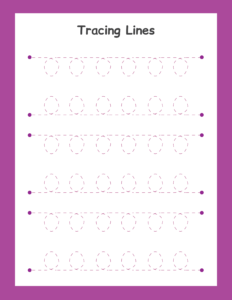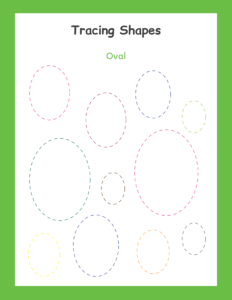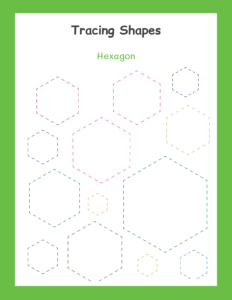Free Printables of Tracing Worksheets for Kids
These worksheets are fantastic tools for helping kids develop essential skills. These worksheets are designed to improve fine motor skills, hand-eye coordination, and early writing abilities. They come in various themes and designs, making learning both effective and fun. Here’s a detailed look at different types of tracing worksheets and their benefits for children.
Types of Tracing Worksheets
- Tracing Lines
Tracing lines worksheets are fundamental for young learners. These worksheets feature different types of lines, such as straight, curved, and zigzag lines. By following the dotted lines, children practice controlling their hand movements and pencil grip. This exercise builds the muscle memory needed for writing and drawing. Starting with simple lines helps kids gain confidence and precision.
- Tracing Shapes
Recognizing and drawing shapes is crucial in early education. Worksheets that focus on tracing shapes like circles, squares, and triangles help kids learn to identify and draw these basic forms. Tracing shapes also aids in improving hand-eye coordination and fine motor skills. These worksheets usually have dotted outlines for children to follow, making it easier to practice shape recognition and drawing.
- Tracing Animals
Animal tracing worksheets are engaging and enjoyable for children. They feature outlines of various animals, such as ducks, cats, and monkeys. By tracing these animal shapes, kids learn about different animals while practicing their drawing skills. The fun and familiar illustrations make the activity more interesting and can keep children motivated to learn.
- Tracing Objects
The worksheets that include everyday objects like planes, oranges, and cars help children connect their drawings to real-world items. These worksheets feature simple outlines of objects, making it easier for kids to practice tracing and drawing. Learning about different objects while tracing them helps kids understand their surroundings better.
- Tracing Fruits
Fruits are a popular theme for tracing worksheets. Outlines of apples, oranges, and other fruits provide a chance for kids to practice drawing while learning about different types of fruit. These worksheets are often colorful and visually appealing, which can make the tracing activity more enjoyable for young learners.
- Tracing More Animals
In addition to common animals, there are worksheets that include less common animals like pigs and rabbits. These worksheets often have more detailed outlines and interesting designs. Tracing these animals helps children learn about a variety of species and enhances their fine motor skills.
- Tracing Everyday Items
The worksheets featuring everyday items like cars, balls, and bikes help children practice drawing things they see regularly. These worksheets often include simple outlines of these items, making it easy for kids to trace and learn about them. Tracing everyday items helps children relate their drawings to their daily experiences.
- Tracing Numbers and Letters
Some of these worksheets focus on numbers and letters. Tracing numbers helps kids practice writing digits, while tracing letters helps with learning the alphabet. These worksheets usually feature dotted lines that guide children in forming numbers and letters correctly. Practicing these skills is essential for early writing development.
Benefits of Tracing Worksheets
The worksheets offer numerous benefits for young learners. They help improve fine motor skills, which are crucial for writing and other daily tasks. Tracing also enhances hand-eye coordination, a vital skill for many activities. Regular practice with tracing worksheets helps children build the necessary skills for more advanced tasks.
Tips for Using Tracing Worksheets
- Start with Simple Designs
Begin with simple shapes and lines. Basic designs are easier for young kids to handle and help build their confidence. As they improve, introduce more complex shapes and patterns.
- Use Different Colors
Adding color to tracing worksheets can make the activity more engaging. Encourage kids to use various colors while tracing. This not only makes it fun but also helps them learn about different colors.
- Practice Regularly
Consistent practice is key for skill development. Set aside regular time each day for tracing activities. This helps kids build and refine their skills over time.
- Provide Praise and Encouragement
Positive reinforcement is crucial. Praise kids for their effort and progress, no matter how small. Encouragement motivates them to keep practicing and improving.
- Incorporate Fun Elements
To make tracing worksheets more enjoyable, consider adding stickers or stamps. These can make the activity more interactive and fun for kids.
- Customize Worksheets
Depending on the child’s interests, customize worksheets to include themes they like. For example, if a child loves animals, focus on tracing worksheets featuring different animals.
- Combine with Other Activities
Integrate tracing worksheets with other learning activities. For instance, after tracing shapes, do a simple craft project using those shapes. This approach reinforces the skills learned.
- Adjust Difficulty Levels
As kids improve, gradually increase the difficulty of the worksheets. This could mean moving from simple shapes to more complex patterns or from basic objects to detailed illustrations.
Conclusion
Free printables of tracing worksheets are valuable resources for young learners. They provide a fun and effective way to develop essential skills such as fine motor control and hand-eye coordination. By using a variety of tracing worksheets, kids can practice tracing lines, shapes, animals, and objects, all while having fun. Regular practice with these worksheets helps build a strong foundation for future learning and writing skills. Start using tracing worksheets today to support children’s skill development and make learning enjoyable.
CLICK ON THE IMAGES TO DOWNLOAD:
TRACING LINES WORKSHEETS:










TRACING PICTURES WORKSHEETS:










TRACING SHAPES WORKSHEETS:











